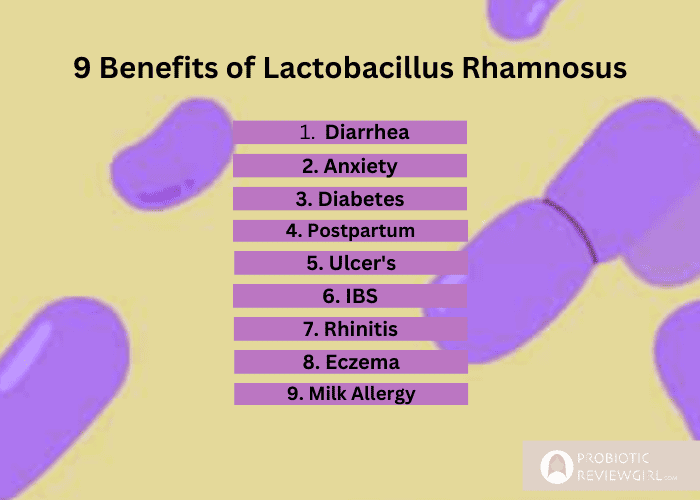9 Lactobacillus Rhamnosus Health Benefits: Psychological, Pregnancy And Allergies

Lactobacillus Rhamnosus is a gram-positive rod shaped strain that was first isolated from a human fecal sample in 1985 and is commonly found in the intestines, vaginal & gastrointestinal tracts of humans.
Lactobacillus rhamnosus provides health benefits through it's ability to promote a healthy gut microbiota, modulate the immune system, and enhance the production of beneficial compounds, resulting in improved mental well-being, reduced pregnancy complications, and alleviation of allergic symptoms.
In this article, I will evaluate the 9 health benefits of Lactobacillus Rhamnosus shown in this diagram

1. Prevents Antibiotic-Associated Diarrhea
Antibiotic-associated diarrhea is a condition characterized by the onset of diarrhea as a result of disruption to the normal gut microbiota caused by the use of antibiotics, often leading to gastrointestinal symptoms and complications. A 2015 review authored by Hania Szajewska, demonstrated the effectiveness of Lactobacillus rhamnosus GG in preventing antibiotic-associated diarrhea in both adults and children.
Another 2011 meta-analysis by authored by Hania, a meta-analysis published showed Lactobacillus rhamnosus GG was a low-cost prevention strategy for healthcare-associated gastroenteritis diarrhea in children, particularly during rotavirus outbreaks in hospital settings.
2. Improves Anxiety In Mice
Anxiety in mice refers to a state of heightened and maladaptive fear or worry-like behavior, which have parallels to anxiety disorders observed in humans. A 2017 authored by Aadil Bharwani, looked into the oral treatment effects of Lactobacillus rhamnosus JB-1 and found that the probiotic strain improved stress-induced anxiety-like behaviour in mice.
The researchers found that mice treated with L. rhamnosus JB-1 showed a decrease in stress-induced anxiety-like behavior and prevented deficits in social interaction with other mice. The Lactobacillus Rhamnosus treatment had an impact on immune cell phenotype, reducing stress-related activation of dendritic cells and increasing IL-10+ regulatory T cells.
3. Improves Gestational Diabetes
Gestational diabetes is a condition characterized by high blood sugar levels that develop during pregnancy in women who did not previously have diabetes.
A 2017 study authored by Kristin L. Wickens tested the administration of Lactobacillus rhamnosus HN001 in 300 pregnant women. The study evaluated the participants at 24-30 weeks and concluded that L. rhamnosus HN001 effectively reduced the incidence of gestational diabetes in the group not receiving a placebo.
4. Improves Postpartum Symptoms
Postpartum symptoms refer to the physical and emotional changes experienced by a woman in the period following childbirth, which may include mood swings, fatigue, pain, and hormonal fluctuations.
Another 2017 study authored by Rebecca Slykerman, again tested Lactobacillus rhamnosus HN001 in pregnant women. It found the administration of Lactobacillus rhamnosus HN001 (HN001) during pregnancy and postpartum significantly reduced symptoms of depression and anxiety in the postpartum period.
Mothers who received the probiotic treatment reported lower depression and anxiety scores compared to those in the placebo group, suggesting that HN001 can be beneficial in preventing or treating postpartum symptoms of depression and anxiety.
5. Heals Gastric Ulcer's In Rats
Gastric ulcers in rats, referring to mucosal injuries in the stomach of these animals, are studied to gain insights into potential treatments for human gastric ulcers, although additional research is needed to establish their direct applicability to human patients.
A 2007 study authored by EKY Lam initially found that Lactobacillus Rhamnosus GG enhanced gastric ulcer healing then a 2022 study authored by Musab Isik found L. Rhamnosus GG was useful for preventing stress induced ulcers.
The administration of Lactobacillus rhamnosus, was able to increase nitric oxide (NO) levels, which protect mucosal integrity, and reduce stress protein HSP70 expression, promoting cellular healing and preventing ulcer development.
6. Relieves IBS Symptoms
IBS symptoms, encompass a range of gastrointestinal issues such as abdominal pain, bloating, altered bowel habits, and discomfort, typically occurring in the absence of any structural abnormalities or underlying disease.
A 2014 study authored by Natalia Pedersen, investigated the efficacy of Lactobacillus rhamnosus GG and the Low FODMAP diet as interventions for individuals with irritable bowel syndrome (IBS).
The study demonstrated that the Lactobacillus Rhamnosus GG group showed a reduction in IBS-SSS. Irritable Bowel Syndrome Severity Score is a scoring system used to assess the severity of symptoms in patients with irritable bowel syndrome, providing a measure of the overall impact of the condition on an individual's well-being.
7. Improves Allergic Rhinitis Treatment
Allergic rhinitis treatment involves various approaches aimed at reducing symptoms such as nasal congestion, sneezing, and itching caused by allergic reactions, which may include medications, allergen avoidance, and immunotherapy.
A 2016 clinical trial authored by Joanna Jerzynska, investigated the benefits of Lactobacillus rhamnosus GG and Vitamin D in children with grass pollen sensitivity and associated allergic rhinitis. Following the treatment period, the children exhibited improvements in symptom-medication scores, lung function, and overall clinical outcomes. L. Rhamnosus GG supplementation demonstrated a superior clinical and immunologic response in children with allergic rhinitis.
8. Protects Against Eczema In Infants
Eczema in infants refers to a common inflammatory skin condition characterized by itchy, red, and dry patches on the skin, typically appearing during the early months or first year of life.
A 2012 study authored by Zachary K Wickens, tested L. Rhamnosus HN001 in 425 infants from New Zealand suffering from various conditions such as dermatitis, eczema, atopy, asthma, and rhinoconjunctivitis.
The findings at the four-year mark revealed a significant reduction in the prevalence of eczema among the study participants. It highlighted the protective effect of L. rhamnosus HN001 supplementation against eczema later in life for high-risk infants.
9. Prevents Cow's Milk Allergy In Infants
Cow's milk allergic infants are infants who experience adverse immune reactions to proteins found in cow's milk, resulting in symptoms such as gastrointestinal discomfort, skin rashes, respiratory issues, and potential growth and development concerns.
A 2015 review titled "Bugs for atopy: the Lactobacillus rhamnosus GG strategy for food allergy prevention and treatment in children" authored by L Cosenza, showed that early-life supplementation with Lactobacillus rhamnosus GG (LGG) was be effective in enhancing the acquisition of oral tolerance in infants with cow's milk allergy.
Does Lactobacillus Rhamnosus Have Side Effects?
Taking probiotics like Lactobacillus Rhamnosus GG can cause minor side effects like upset stomach, diarrhea and gas but this usually passes after several weeks. Out of all the studies featured in this Lactobacillus Rhamnosus benefits guide, there were no serious side effects in any participants reported. Serious side effects that require emergency help include, difficulty breathing, swelling and hives.
is lactobacillus rhamnosus safe during pregnancy?
Lactobacillus rhamnosus is generally recognized as safe but the FDA does not endorse the strain in it's pregnancy category. In the earlier Kristin L. Wickens studies for the 3rd and 4th benefits, Lactobacillus Rhamnosus GG was not associated with any adverse effects during pregnancy but talk to your doctor first before using L. Rhamnosus if you are pregnant.
Lactobacillus Rhamnosus GG Vs Lactobacillus Acidophilus
Lactobacillus rhamnosus and Lactobacillus acidophilus share similarities in their classification since both strains belong to the family Lactobacillaceae and the order Lactobacillales. They are both gram-positive bacteria, retaining the purple color after the gram staining procedure. However, they differ in their specific species and strains.
Lactobacillus rhamnosus is known for its health benefits in promoting gut health, supporting the immune system, and managing digestive disorders. Lactobacillus acidophilus, on the other hand, is recognized for its ability to create an acidic environment in the gut, which can support digestive health.
What Is lactobacillus rhamnosus gr-1?
Lactobacillus rhamnosus GR-1® is a well-studied strain of probiotic that is known for its benefits in women's intimate health. It has been extensively researched and shown to help with conditions such as thrush, bacterial vaginosis, and urinary tract infections (UTIs).
This strain works by improving the balance of vaginal microflora and preventing the adhesion of harmful pathogens. It produces lactic acid, which lowers the pH in the vagina, creating an unfavorable environment for pathogens to thrive.
Lactobacillus rhamnosus GR-1® has also been found to be safe for consumption and has good survival rates in the gut and vagina. It is considered a valuable probiotic for maintaining women's intimate health.
What Is Lactobacillus rhamnosus Ha-114?
Lactobacillus rhamnosus HA-114 is a probiotic strain that has been found to improve eating and mood-related behaviors in overweight adults during a diet-induced weight loss program.
In a recent clinical trial, it was shown to enhance self-control, reduce binge eating and food cravings, and alleviate perceived stress and other mood-related behaviors. This probiotic also supports weight management efforts by restoring the balance of eating behaviors through the brain-gut axis.
Lactobacillus rhamnosus HA-114 has been granted health claims in Canada, making it a promising addition to weight management programs that involve a calorie-reduced diet and regular physical activity.
What Is lactobacillus rhamnosus cncm i-3690?
Lactobacillus rhamnosus CNCM I-3690 is a strain of probiotic bacteria that has been studied for its effects on gut barrier function.
A 2015 study authored by Laval, showed CNCM I-3690 has anti-inflammatory properties and can protect the integrity of the intestinal epithelium. In a mouse model of increased colonic permeability, L. rhamnosus CNCM I-3690 was found to be as effective as the beneficial human commensal bacterium Faecalibacterium prausnitzii A2-165 in normalizing colonic permeability.
CNCM I-3690 partially restored the function of the intestinal barrier and increased the levels of tight junction proteins, such as Occludin and E-cadherin. These findings suggest that Lactobacillus rhamnosus CNCM I-3690 could be a treatment option for functional barrier abnormalities in the gut.
what is lactobacillus rhamnosus with FOS?
Lactobacillus Rhamnosus with FOS refers to the strain being in a probiotic supplement with FOS prebiotic fiber.
FOS (fructooligosaccharides) prebiotic is a type of dietary fiber that selectively stimulates the growth and activity of beneficial bacteria in the gut, promoting a healthy gut microbiota and improving digestive health.
A 2020 study by M. Azam found that extracting fructooligosaccharides (FOS) from banana peel and using them as an encapsulation method resulted in better encapsulation efficiency for Lactobacillus rhamnosus. It aimed to improve the survival of L. rhamnosus by optimizing the interaction between FOS and sodium alginate (SA) as encapsulation materials.
Dr. Sara Mesilhy has a Master’s degree in Gastroenterology and holds a membership with the Royal College of Physicians of the United Kingdom. She completed her Bachelor of Medicine, Bachelor of Surgery (MBBS) at Cairo University and is currently part of the ProbioticReviewGirl medical team.